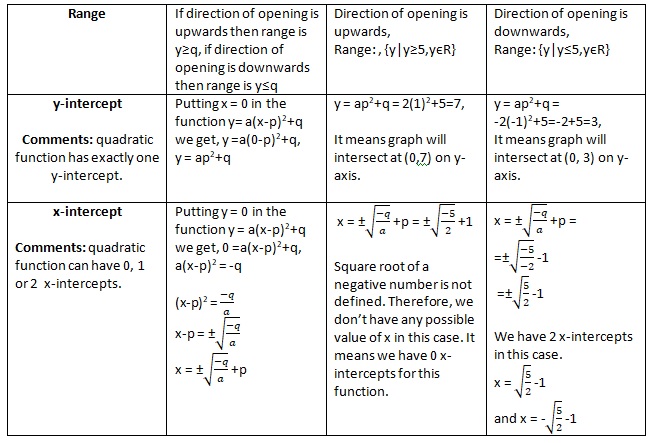How To Find Domain And Range Of Vertex Form
Follow this weblog and be one step ahead.
Vertex course of Quadratic Functions is
![]()
where
![]()
It can give us lots of information most the quadratic function like location of vertex, domain, range, axis of symmetry, minimum or maximum value etc. In this article if you stay with me you tin can easily learn how to observe all these variables.


Vertex:Location of vertex is (p, q) for function
![]()
. If our part is
![]()
then its vertex would be located at (2, 3). If our role is
![]()
then its vertex would be located at (-v, -two). If our role is
![]()
and then its vertex would exist located at (-five, 2).
Note that
![]()
can be written as
![]()
to find value of p and q when we compare it with
![]()
.
Management of Opening:Direction of opening of graph is upwards if
![]()
. If,
![]()
then direction of opening of graph would be downwards. Instance, direction of opening of
![]()
would be up. Direction of opening of
![]()
would be downwards. Visit Learn direction of opening of quadratic functions by sketching.
Minimum or Maximum Value: When graph of function is going upwards then nosotros take minimum value which is y=q. If management of opening is downwards so nosotros have maximum value which is also y=q. For quadratic office
![]()
which is opening upwards nosotros will take minimum value which would exist
![]()
i.e
![]()
. For quadratic function
![]()
which is opening downwards nosotros will have maximum value. Our maximum value would be
![]()
which is
![]()
.
Centrality of Symmetry:Centrality of symmetry is a directly vertical line which divides graph of quadratic function into two equal parts. It passes through the vertex of the graph. Equation of centrality of symmetry is ever equal to
![]()
. If we take quadratic part
![]()
so by comparing information technology with
![]()
, we take
![]()
. Therefore, equation of axis of symmetry is
![]()
. If nosotros have quadratic role
![]()
then past comparing it with
![]()
, we accept
![]()
. Therefore, equation of axis of symmetry is
![]()
. For function
![]()
, equation of axis of symmetry would be
![]()
which shows in film c.
Domain:Domain is the drove of all
![]()
values nowadays on the graph of quadratic function. In well-nigh of the cases, domain of the quadratic function would be all real numbers which tin be written as {
![]()
}. There are unlike notations to represent this. One of the notation can exist written like (
![]()
). But in some cases our domain tin can be different. For example, nosotros have vertex role
![]()
and If I hypothetically say that y is the distance covered in meters and
![]()
is the time taken in seconds. Domain here cannot be all real numbers because fourth dimension cannot be in negative. Domain in this case would be {
![]()
}. For function
![]()
, its graph is drawn above in picture c. Domain hither is all existent numbers. As graph moves upwards, it covers all the negative values in -x direction and all the positive values in the +x direction.
Range: Range is the drove of all
![]()
values nowadays on the graph of quadratic function. Range depends on two separate cases.
If our graph is going downwards then we have maximum value. Our range in this case would be {
![]()
}.
If our graph is going upwards then nosotros have minimum value. Our range in this instance would be {
![]()
}. For part
![]()
nosotros have graph drawn above in picture c. Range in this instance would be {
![]()
}. You can note that
![]()
value of the graph is minimum at
![]()
. We don't have y value less than ii but all the y values are greater than or equal to two.
y-intercept: y-intercept is the point where graph meets y-axis. Quadratic function has exactly one y-intercept.
To notice y-intercept nosotros put x =0 in the function
![]()
we get
![]()
![]()
Instance, we have quadratic function
![]()
y-intercept for this role
![]()
It means that graph is going to intersect at bespeak (0,-v) on y-axis.
x-intercept: x-intercept is the bespeak where graph meets x-centrality. Quadratic function tin can have 0,1 or 2 x-intercepts.
To find x-intercept we put y =0 in the function
![]()
nosotros get
![]()
![]()
![]()
![]()
![]()
![]()
Source: https://mathinstructor.net/2018/10/quadratic-functions-in-vertex-form-how-to-find-vertex-domain-range-axis-of-symmetry-minimum-or-maximum-direction-of-opening-x-intercept-y-intercept/
Posted by: romerofeliked.blogspot.com


0 Response to "How To Find Domain And Range Of Vertex Form"
Post a Comment